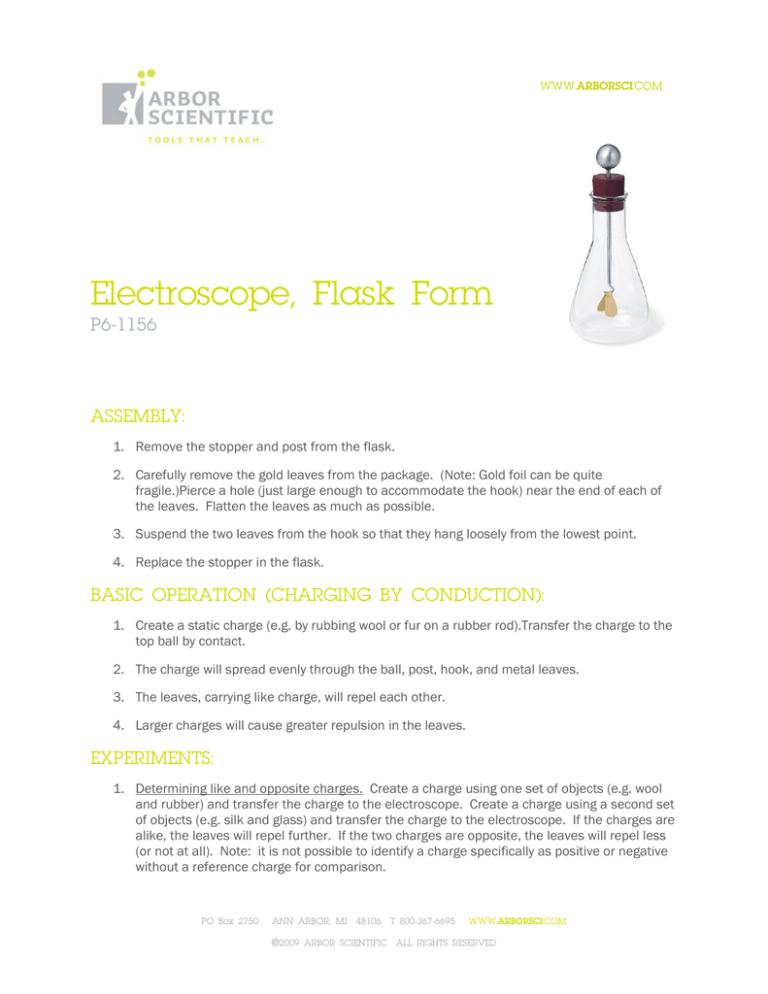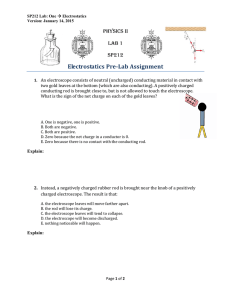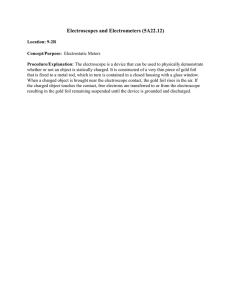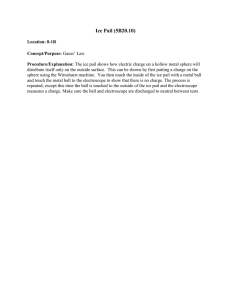
WWW.ARBORSCI.COM
Electroscope, Flask Form
P6-1156
ASSEMBLY:
1. Remove the stopper and post from the flask.
2. Carefully remove the gold leaves from the package. (Note: Gold foil can be quite
fragile.)Pierce a hole (just large enough to accommodate the hook) near the end of each of
the leaves. Flatten the leaves as much as possible.
3. Suspend the two leaves from the hook so that they hang loosely from the lowest point.
4. Replace the stopper in the flask.
BASIC OPERATION (CHARGING BY CONDUCTION):
1. Create a static charge (e.g. by rubbing wool or fur on a rubber rod).Transfer the charge to the
top ball by contact.
2. The charge will spread evenly through the ball, post, hook, and metal leaves.
3. The leaves, carrying like charge, will repel each other.
4. Larger charges will cause greater repulsion in the leaves.
EXPERIMENTS:
1. Determining like and opposite charges. Create a charge using one set of objects (e.g. wool
and rubber) and transfer the charge to the electroscope. Create a charge using a second set
of objects (e.g. silk and glass) and transfer the charge to the electroscope. If the charges are
alike, the leaves will repel further. If the two charges are opposite, the leaves will repel less
(or not at all). Note: it is not possible to identify a charge specifically as positive or negative
without a reference charge for comparison.
PO Box 2750
ANN ARBOR, MI 48106 T 800-367-6695
WWW.ARBORSCI.COM
©2009 ARBOR SCIENTIFIC ALL RIGHTS RESERVED
2. Charging by Induction. Charge an object and hold it near the ball without touching. The
leaves will repel even though the electroscope is still neutral. Suppose the external object
carries a negative charge (excess electrons). When held near the electroscope, free
electrons in the metal are repelled from the charged object near the ball. They move down
the post into the leaves, causing the leaves to carry an overall negative charge. (The ball has
a positive charge.).
ADDITIONAL ACTIVITIES FOR THE GENERATION OF STATIC
ELECTRICITY:
Activity One: The Electrophorus
Note: In the following activity the polyethylene rod or some other type of plastic rod or strip is used to
produce the initial charge. It may be instructive to have the students try many materials to see if
there is any difference in the amount of charge that each material will create. You will also need a
flat acrylic plate, flat metal plate, acrylic sheet, various cloth materials and a neon bulb.
The electrophorus, which means “electric carrier”, is a very simple and easy to make electrostatic
generator. It is just a flat acrylic plate that is rubbed with a cloth or other material by hand. This
builds up static in the plate, which can then be transferred to a flat metal plate that has an insulated
handle. Different materials rubbed on the acrylic plate will have different effects.
Place an acrylic sheet on a flat surface and rub it briskly
with the polyethylene rod. Do not touch the sheet with
your hand. It is easiest if the sheet is placed at the edge
of a desk or table, and the rod is held so that the handle
is over the edge. When a charge has been built up on the
sheet, place the electrophorus on the sheet with the
handle in the air. Some of the electrons on the charge
sheet will move to the neutral electrophorus, giving it a
charge. If there is sufficient charge and you bring the
electrophorus away from the sheet and touch it with your
finger you should feel or hear a small spark as the charge jumps the gap from the electrophorus to
your finger.
Recharge the sheet and use it to charge the electrophorus. This time touch a small neon bulb to the
electrophorus. If the charge is sufficient you should see the bulb glow as the charge is transferred.
PO Box 2750
ANN ARBOR, MI 48106 T 800-367-6695
WWW.ARBORSCI.COM
©2009 ARBOR SCIENTIFIC ALL RIGHTS RESERVED
Activity Two: The Electroscope
The electroscope is a device used for detecting a difference in electrical potential of an object. The
word scope means “to see” and an electroscope is designed to allow you to see the presence or
absence of an electrical charge.
Note: This activity requires various friction rods of different materials, including solid glass, nylon,
acrylic, polystyrene, PVC and polyethylene. You will also need an acetate cloth, polyethylene bag and
a balloon.
To begin you will need some way to test the electrostatic
charges. Usually for this you will use some sort of electroscope.
You can use any type or make one using a drinking glass or a
beaker and tape cotton thread to it as shown. This cotton thread
will act as a simple electroscope. That is, it will be used to
determine the presence of an electric charge.
Before you test a rod, bring each up against a grounded item, such as a metal desk, radiator or water
pipe. This will help discharge the items before testing them with a different material.
Now, take each of your friction rods and, one at a time, test each with acetate cloth and polyethylene
bag by rubbing them on the rod. Bring the item being tested close to the thread and watch the
thread’s movement. Note in the chart below what type of rod was used, what type of pad was used
and, using a scale of 1 to 5 with 5 being the greatest attraction to the thread, what were the results.
ROD TYPE
ACETATE
POLYETHYLENE
Attracted to the thread on a scale of 1 to 5
Solid Glass
Nylon
Acrylic
Polystyrene
PVC
Polyethylene
PO Box 2750
ANN ARBOR, MI 48106 T 800-367-6695
WWW.ARBORSCI.COM
©2009 ARBOR SCIENTIFIC ALL RIGHTS RESERVED
Activity Three: The Pith Ball Electroscope, Attraction and Repulsion
An electroscope works because of the nature of electrons. More simply because opposite charges
attract and the same charges repel one another. If an object that is highly charged with negative
charged atoms (electrons) is brought near to two aluminum painted cork balls (used to be made
from pith) hanging side by side, the positive atoms on the balls will be attracted towards that object.
This will cause them to swing in the direction of the object being tested. If the object touches
the balls, some of the electrons will be transferred to the balls. This makes both balls negatively
charged which, in turn, caused the balls to repel one another. The more negative they are the more
they will push each other away. This gives you a visual of the strength of the present charge.
Take a cork ball set (or pith ball set) and suspend one ball by wrapping the other around an insulated
hanger. This can be a hook on a wooden dowel, a piece of wire on an insulated base, or you can use
a glass as in the previous electroscope (see illustration above). Charge the electrophorus and bring it
near the ball. Since the ball is neutral, it has both a positive and a negative charge. As the
electrophorus gets near, the negative charges on it attract the positives on the ball, and repel the
negative charges. This causes the negative charges to move to the far
side of the ball, and the positive charges to move to the near side. Since
the opposite charges attract, the side of the ball nearest the
electrophorus will be attracted to the electrophorus and the ball will
swing that way. If the charge is strong enough and the two objects are
near enough, the ball will actually touch the electrophorus. When this
happens some of the negative charge on the electrophorus will be
transferred to the ball and both will become negatively charged. As soon
as this happens the like charges will repel each other and the ball will
swing away from the electrophorus.
You may also use a PVC rod with the attached metal ball as a transfer apparatus. You will probably
have even better results because the PVC rod acts as an insulator.
Next, take the cork balls (one on each end of a string) and suspend them from an insulated hanger
so that they are free to move in any direction. Charge the transfer ball and move it near the balls.
The balls should move away from the transfer ball, just as the cork ball did. Touch one of the balls
with the transfer ball, and watch what happens. The ball that was touched will swing away from the
transfer ball and will touch the other ball. Each time some of the negative charge is transferred, so
that both balls end up with a negative charge. If you recharge the transfer ball, and touch one of the
balls again, more charge will be transferred and the two balls repel each other more. Eventually, you
will find it impossible to bring the transfer call in contact with either of the balls, and they will not be
able to touch each other.
PO Box 2750
ANN ARBOR, MI 48106 T 800-367-6695
WWW.ARBORSCI.COM
©2009 ARBOR SCIENTIFIC ALL RIGHTS RESERVED
Activity Four: The Flask Electroscope
A very common type of electroscope and one that has been around
for a long time is the flask electroscope (P6-1156). This item can be
very sensitive and, because it is enclosed within a glass housing, it
is not prone to being affected by air currents in the room.
Rather than using pith balls or cork balls for indicating the presence
of charges, it uses very thin metal foil leaves. Another big difference
is the way that the charge is induced on to these leaves. Rather
than the object being tested coming in direct contact with the
leaves, the charge is introduced to a metal post to which the leaves
are attached. The charge is then transferred from the post to the
leaves. The foil leaves then act in a similar manner to the cork balls.
Note: The following flask electroscope activities require two flask
electroscopes, a rubber, plastic and glass rod, a piece of wool and
silk cloth, as well as two metal disk terminals for using in place of
the metal terminal ball found at the top of a standard flask electroscope. You will also need an
acrylic sheet and a neon bulb.
First, set both flask electroscopes up with metal balls on the top of their post. Discharge the
electroscope by touching the balls with your hand or against a metal disk or similar object. When the
electroscopes are discharged both leaves should hang straight down.
Take a rubber or plastic rod and rub it with a piece of wool cloth or similar material. When the rod is
rubbed with the material, electrons are rubbed off the cloth and onto the rod. When a rod is brought
near the ball (but not touching) the electrons that are already present on the rod are forced toward
the leaves. This is due to the repulsion of similar charges. When both leaves have an over
abundance of electrons they repel one another causing them to separate from one another. When
the rod is removed the leaves should return to their earlier state.
Now bring the rod back to the ball but this time actually touch the ball. This time you should find that
the leaves remain diverged when you remove the rod. This is because some of the electrons from the
rod transfer to the post, which remains on the rod and leaves after you take the rod away. The
electroscope will remain in this state until it is discharged. This can happen by touching the ball to
something else that will attract some of the excess electrons or by leaking through the air. The time it
takes to leak and return back to a normal state depends on the amount of charge and the humidity
of the environment.
PO Box 2750
ANN ARBOR, MI 48106 T 800-367-6695
WWW.ARBORSCI.COM
©2009 ARBOR SCIENTIFIC ALL RIGHTS RESERVED
Now remove the balls from the electroscopes and replace them with metal disks. With the plates
touching, charge one as in the illustration. Both electroscopes should now show a charge. Discharge
one of the electroscopes by touching it with your hand. You should see that both discharge showing
how the charges can transfer from one to the other. Finally, charge one of the electroscopes and
then bring the charged electroscope to the other and allow the plates to touch again. You will find
that some of the charge will transfer to the second electroscope. The movement of the foil leaves in
the second electroscope will indicate this.
By using a glass rod rubbed with silk, you can generate an excess of positive charge on the rod. You
will find that the electroscope will respond in the same way.
Next, take the electroscope and discharge it (to remove any residual charge) by touching it with your
finger. The leaves should be hanging nearly straight down with only a small angle between them.
Charge the electrophorus on the sheet, and bring it CLOSE to the electroscope. Do not touch the
terminal! The leaves of the electroscope should move far away from each other slightly. The stronger
the charge on the electrophorus the more they should repel each other. As you move the
electrophorus away from the electroscope the leaves should return to a neutral state. Why does this
happen? The high charge on the electrophorus (negative) repelled some positive charges on the
terminal of the electroscope. The only place these positive charges could go was to the leaves of the
electroscope. Since the two leaves then had the same charge, and since like charges repel each
other, the leaves moved away from each other. When the electrophorus was removed, the positive
charges could go back, returning the electroscope to a neutral state.
Again charge the electrophorus. This time touch the plate to the terminal of the electroscope. The
leaves should move apart. However, this time the charge is due to an actual transfer of electrons, so
it remains even when the electrophorus is removed. If this is repeated several times it is possible to
build up a relatively strong charge on the electroscope, so that the leaves are standing well apart
from each other. To return the electroscope to the uncharged state, touch the terminal with your
finger. Charge it again, but this time discharge it by touching it with a neon bulb. If the charge was
strong enough the bulb should light up briefly.
Charge an acrylic sheet again using the polyethylene rod. Take the transfer ball and rub it over the
sheet, then touch it to the terminal of the electroscope. Repeat this several times, building a stronger
charge on the electroscope. Note that each time you rub the ball over the sheet you are collecting
more electrons, which are transferred to the electroscope. This is the mechanical transfer of static
charge. This cannot be done with current electricity.
Activity Five: Point Discharge and a Flask Electroscope
Note: This activity requires one flask electroscope and a discharge point.
To begin, discharge one of the flask electroscopes. Charge the transfer ball and move it near the
electroscope. The leaves should deflect, showing an induced charge. Keeping the ball away from the
electroscope, touch it with the back of the point. Now move the ball near the electroscope. This time
the leaves should not move much, if at all. Obviously, the charge has been transferred to the point.
Move it near the electroscope. Again the leaves will not move, showing that the point has no charge.
Where did the charge go?
Try one more thing. Charge the transfer ball and hold it near the electroscope. Now aim the sharp
point at the disk of the electroscope and touch the transfer ball to the other end of the point. This
time the charge should move to the electroscope, and some should remain even after the transfer
ball and point are removed. Apparently the charge on a point is rapidly transferred to the air, and if
PO Box 2750
ANN ARBOR, MI 48106 T 800-367-6695
WWW.ARBORSCI.COM
©2009 ARBOR SCIENTIFIC ALL RIGHTS RESERVED
the electroscope is near enough the charge will go there. This is the principle behind lightning rods.
The idea is not so much to attract lightning to a particular point as to remove as much charge as
possible from the building the lightning rod is attached to.
Activity Six: Induced Charge and Flask Electroscopes
Note: This activity requires two flask electroscopes and two metal disk terminals.
To begin, remove the ball terminals from the electroscopes and replace them with disk terminals.
Place the two electroscopes so that the disks are touching. Be certain that the two electroscopes are
discharged. Charge the transfer ball and bring it close to the far side of one of the electroscopes.
Note that both will show a charge. Being careful not to touch either of the disks, slide the two
electroscopes apart. Move the transfer ball away. Both the electroscopes should now show a charge.
Recharge the transfer ball and touch the terminal of one of the electroscopes. If that electroscope
was negatively charged the leaves should move farther apart. If, on the other hand, it was positively
charged, the leaves should move together, showing that the positive charge has been neutralized.
Why are the two charged when there was no contact with the transfer ball, and why are they
oppositely charged?
When the two were touching, they acted as one object. Therefore, when the transfer ball was moved
near one edge, the negative charges on the combined plates were repelled from the transfer ball
and moved to the far edge of the far electroscope. The positive charges were attracted to the
transfer ball, and they moved to the near side of the near electroscope. While they were in this state
the connection between them was broken, and when the transfer ball was removed it was
impossible for the charges to move back to their original position. This resulted in an excess of
positive charges on one electroscope, and an excess of negative on the other. Both, however, were
charged so that the foil leaves were repelled.
RELATED PRODUCTS:
Extra Gold Foil Leaves (P6-1157)
Electrostatics Demo Kit (P6-1600). Rubber and glass rods, fur, and silk flannel for creating positive
and negative charges
Hand Crank Van de Graaff Generator (P6-3400)
Coated Pith Balls (P6-1650)
PO Box 2750
ANN ARBOR, MI 48106 T 800-367-6695
WWW.ARBORSCI.COM
©2009 ARBOR SCIENTIFIC ALL RIGHTS RESERVED



